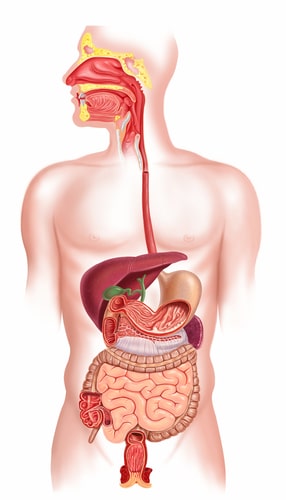
The Alimentary Canal:
The mouth and throat are the beginning of the alimentary canal. The first step in the digestive process is putting food in your mouth. But before that, you see and smell your food and this causes saliva to be produced. The saliva softens your food and makes chewing easier.
After food is chewed sufficiently, it moves to the back of the throat and down a tube called the esophagus. The muscles in this tube move rhythmically to push food to the sphincter ring, which opens at the right time to allow food to enter the stomach.
Stomach:
Once the food is in the stomach, enzymes, acids and digestive juices are released and break down the food particles even more. This process takes a while. From the stomach, the food is directed down to the small bowel.
The small bowel, gallbladder, pancreas, and liver:
When the particles enter the small bowel, the gallbladder receives a signal to contract and squeeze juices and bile to the small bowel to break down food into even smaller particles. Next, the liver steps in to do its job. It’s been busy producing proteins and bile that is stored in the gallbladder until the system needs these substances. At this time the liver collects and stores iron, vitamins and trace elements from food. Perhaps the most important job of the liver is to detoxify everything that is taken into the body including food, beverages, and medication in order to remove harmful elements.
While food is still in the small intestine, the pancreas is prompted to release enzymes to aid in the digestion of proteins, fats, and carbohydrates. It also releases insulin, which helps metabolize sugars.
The juices supplied from the gallbladder and pancreas break down the food particles into molecules, which then pass through the lining of the small bowel into the blood, and are carried throughout the body to where they are needed. Once the food molecules have passed out of the small bowel into the large intestine, miraculously all the juices and enzymes are turned off.
The final process:
All substances that aren’t absorbed into the blood pass into the large intestine. Liquid waste is processed through the kidneys and bladder and pass from the body as urine. The large intestine absorbs fluids and bile salts, and all waste products are eliminated from the body.
This journey of the food you eat can take anywhere from 6 – 12 hours depending on the kind of food you eat. The body has to work harder to digest fats. The entire gastrointestinal system is about 25 feet long. It’s a long group of connected canals that everything we ingest goes through.
What a perfectly synchronized system! When it is working properly, you’re hardly aware that all this activity is going on. However, if something goes wrong anywhere along the way, there will be some degree of discomfort.
Related Articles By Cathe:
5 of the Most Common Digestive Issues Related to Exercise
Obesity and Carbohydrates: Do Some Obese People Digest Carbohydrates Differently?
How to Improve Digestion by Eating for Your Blood Type
Natural Fiber is Healthy, but What About Synthetic Fiber in Foods?

